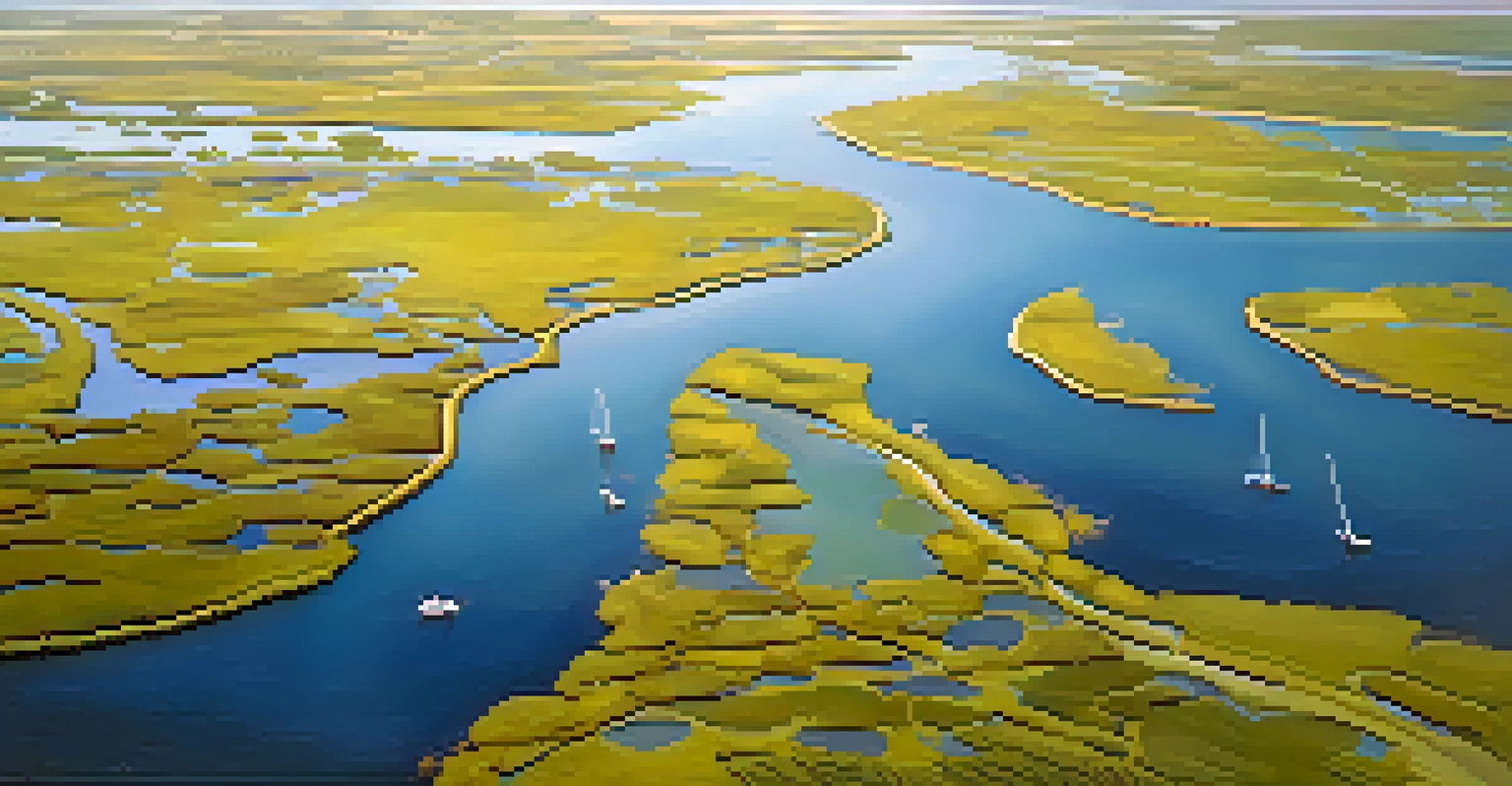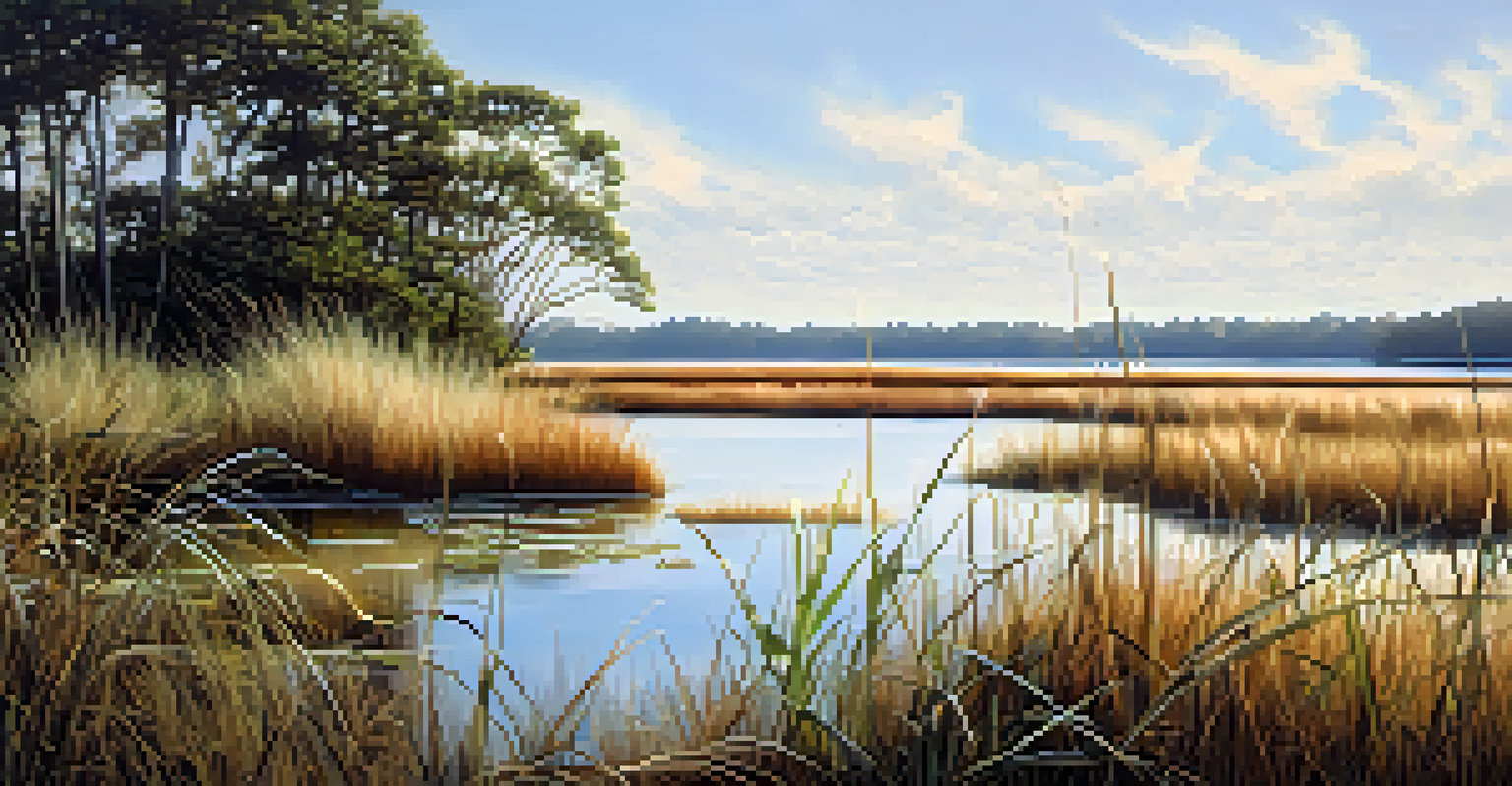Impact of Coastal Climate Zones on North Carolina's Biodiversity

Understanding Coastal Climate Zones in North Carolina
North Carolina's coastal climate zones are defined by their unique temperature, humidity, and precipitation patterns. These zones are influenced by both the Atlantic Ocean and the state's geographical features, which create a variety of microclimates. From the warm, humid Outer Banks to the milder coastal plains, each area presents distinct environmental conditions. This diversity in climate plays a crucial role in supporting a wide range of plant and animal species.
Water and air, the two essential fluids on which all life depends, have become global garbage cans.
The coastal climate zones can be broadly classified into three categories: the humid subtropical zone, the marine zone, and the transitional zone. Each of these climates contributes differently to the overall biodiversity of the region. For example, the humid subtropical zone typically supports lush forests and diverse wildlife, while the marine zone is characterized by salt marshes and estuaries that are vital for many aquatic species.
Understanding these climate zones is essential for conservation efforts, as they provide a framework for how different ecosystems function. By examining the interplay between climate and biodiversity, we can better appreciate the intricate relationships among species and their habitats in North Carolina.
The Role of Temperature in Biodiversity
Temperature variations significantly impact the types of species that thrive in North Carolina's coastal zones. Warmer temperatures can lead to longer growing seasons, which benefits many plants and animals. However, increased heat can also stress certain species, particularly those already at risk due to habitat loss or other environmental factors. This delicate balance is crucial for maintaining biodiversity in the region.

For instance, some migratory bird species rely on specific temperature ranges to find suitable nesting sites. If temperatures rise too much, these birds might arrive too early or too late, disrupting their reproductive cycles. Similarly, marine species like fish may shift their ranges in response to changing water temperatures, which can affect the entire marine ecosystem.
Diverse Climate Zones in NC
North Carolina's coastal regions feature unique climate zones that support a rich variety of plant and animal species.
Thus, temperature not only shapes the survival of individual species but also influences the overall health of ecosystems. By monitoring temperature trends, conservationists can better predict potential impacts on biodiversity and implement strategies to mitigate adverse effects.
Precipitation Patterns and Their Impact
Precipitation is another critical factor influencing biodiversity in North Carolina's coastal regions. The amount and timing of rainfall can affect soil moisture levels, which in turn impacts plant growth and animal habitats. For example, areas that receive consistent rainfall tend to support dense forests, while drier regions may feature more drought-resistant vegetation.
In nature's economy, the currency is not money, it is life.
Moreover, extreme weather events, such as hurricanes or heavy storms, can drastically alter landscapes and disrupt ecosystems. Flooding may wash away habitats, while drought can limit freshwater resources, putting pressure on both terrestrial and aquatic species. Understanding these precipitation patterns is vital for predicting how ecosystems will respond to changing climate conditions.
Ultimately, the interplay between precipitation and biodiversity underscores the importance of sustainable water management practices. By ensuring that ecosystems have access to adequate water supplies, we can help maintain the delicate balance that supports North Carolina's diverse wildlife.
Human Influence on Coastal Climate Zones
Human activities have significantly altered North Carolina's coastal climate zones, impacting biodiversity in both direct and indirect ways. Urban development, agriculture, and industrial activities contribute to habitat destruction and fragmentation, which can threaten local species. Additionally, pollution from these activities can degrade water quality and disrupt the delicate balance of coastal ecosystems.
For example, coastal development often leads to the loss of wetlands, which serve as critical habitats for many species. Wetlands also play a vital role in water filtration and flood control, making their preservation essential for both biodiversity and human communities. When these areas are compromised, the ripple effects can be felt throughout the entire ecosystem.
Temperature Affects Biodiversity
Temperature variations directly influence species survival and ecosystem health in North Carolina's coastal areas.
To protect biodiversity, it is crucial to implement sustainable practices that minimize human impact on coastal climate zones. This might include preserving natural habitats, enforcing stricter pollution controls, and promoting responsible land use. By taking proactive steps, we can help safeguard the rich biodiversity that characterizes North Carolina's coastal regions.
The Importance of Coastal Ecosystems
Coastal ecosystems, such as marshes, estuaries, and barrier islands, are vital for maintaining biodiversity in North Carolina. These areas provide critical habitats for numerous species, including migratory birds, fish, and plant life. They also serve as nurseries for juvenile marine species, helping to sustain healthy fish populations that are essential for both the environment and local economies.
In addition to supporting wildlife, coastal ecosystems offer numerous benefits to humans, such as recreation, tourism, and natural protection against storms and erosion. The intricate web of life within these ecosystems highlights the interconnectedness of species and their habitats. When one element is disrupted, it can have cascading effects on the entire system.
Protecting these ecosystems is paramount for preserving biodiversity and ensuring that future generations can enjoy the natural beauty and resources of North Carolina's coast. Conservation efforts must focus on maintaining the health of these areas to support both wildlife and human communities alike.
Conservation Efforts and Strategies
Conservation efforts in North Carolina are increasingly focused on protecting and restoring coastal climate zones to safeguard biodiversity. Organizations are working to establish protected areas, promote sustainable land-use practices, and restore degraded habitats. By bringing together scientists, policymakers, and local communities, these initiatives aim to enhance resilience against climate change and habitat loss.
One successful example is the establishment of marine protected areas (MPAs), which help to conserve critical habitats and ensure sustainable fishing practices. These areas provide safe havens for marine species, allowing populations to recover and thrive. Additionally, public awareness campaigns help educate communities about the importance of coastal ecosystems and encourage responsible stewardship.
Human Impact on Coastal Ecosystems
Urban development and pollution threaten the delicate balance of North Carolina's coastal ecosystems, impacting biodiversity.
While significant progress has been made, ongoing efforts are necessary to address the challenges posed by climate change and human activity. By continuing to invest in conservation strategies, we can protect North Carolina's rich biodiversity and maintain the health of its coastal climate zones.
Future Challenges and Opportunities
Looking ahead, North Carolina's coastal biodiversity faces several challenges due to climate change, urbanization, and habitat degradation. Rising sea levels threaten to inundate low-lying areas, while increased temperatures and extreme weather events can disrupt delicate ecosystems. These factors not only endanger local wildlife but also impact the livelihoods of communities that depend on healthy coastal environments.
However, these challenges also present opportunities for innovation and collaboration. By investing in research and technology, we can develop new strategies for biodiversity conservation and ecosystem restoration. Engaging local communities in conservation efforts can foster a sense of ownership and responsibility, empowering individuals to make a positive impact on their environments.

Ultimately, the future of North Carolina's coastal biodiversity depends on our collective actions today. By addressing challenges and seizing opportunities, we can work towards a sustainable future that preserves the rich natural heritage of the region for generations to come.